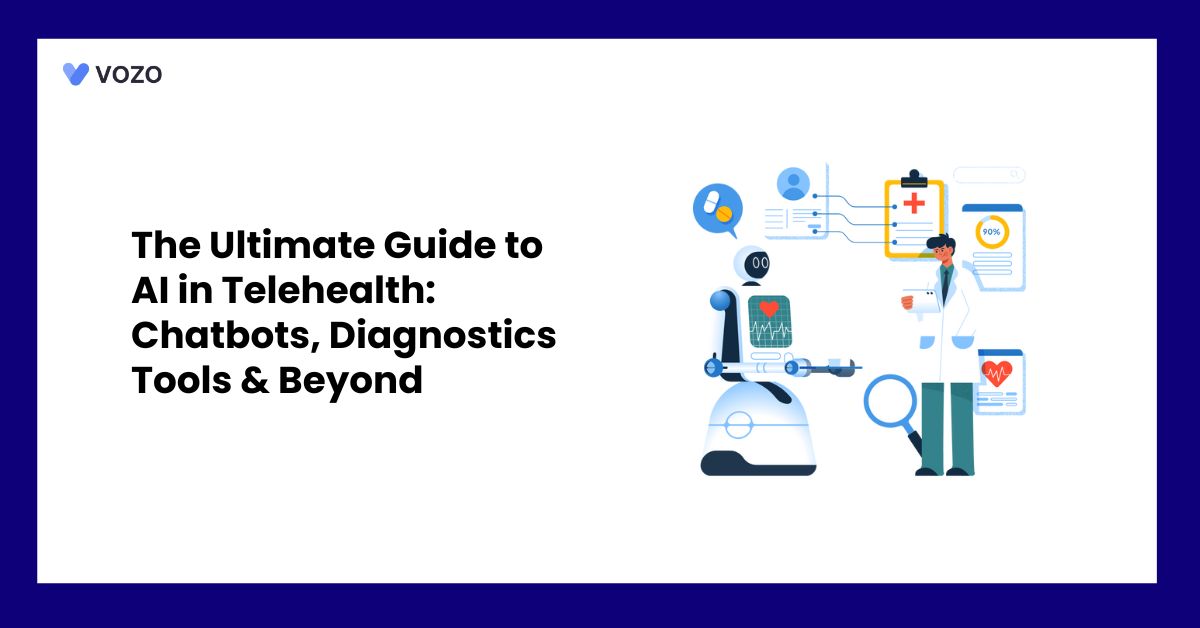The Ultimate Guide to AI in Telehealth: Chatbots, Diagnostics Tools & Beyond
AI is transforming telehealth, offering faster care, smarter diagnostics, and more efficient workflows, but many providers aren’t sure where or how to begin.
With so many potential applications, from chatbots to remote monitoring, it can be hard to know which AI tools are right for your practice.
This blog breaks down the common AI applications used and explores challenges to know so you can make informed decisions and deliver better virtual care.
AI in Telehealth
Artificial intelligence refers to computer systems that can execute activities that would usually require human intelligence, such as pattern recognition, natural language comprehension, and decision making.
In telehealth, AI enhances virtual care by evaluating patient data, automating routine activities, and improving clinical and operational workflows.
- AI-driven technologies focus on prioritizing urgent patients by assessing symptoms and medical history, achieving improved diagnostic accuracy rates.
- Chatbots and virtual assistants automate telehealth appointment scheduling, follow-ups, and reduce administrative burdens for staff.
- Generative AI automatically creates clinical notes and offers suitable billing codes based on visit transcripts, decreasing documentation time and errors.
Related: 10 Must-Know Telehealth Innovations Transforming Mental Health Practices
Common AI Applications Used in Telehealth
1. AI-Powered Clinical Documentation
AI assists in note-taking during telehealth sessions and generates clinical notes based on the summaries. This saves time by ensuring thorough record-keeping and improving documentation accuracy.
AI scribes translate the conversation into an organized and structured medical documentation. It reduces clinician after‑visit workload by up to 30% and cuts coding errors significantly.
2. Remote Patient Monitoring
RPM enables continuous monitoring of patients’ health, reducing frequent hospital visits. RPM with AI has wearable devices and sensors that collect data of a patient’s vital signs, such as blood pressure, glucose levels, and heartbeat. AI-powered devices transmit the data into providers’ systems.
AI algorithms continuously monitor and alert clinicians when they detect any abnormalities in a patient’s health. It identifies potential health issues and provides early treatments.
3. Virtual Assistants and Conversational Bots
The main applications of AI in telehealth consist of virtual health aides and chatbots. These tools facilitate prompt and customized engagements with patients. It answers questions, offers advice regarding their health conditions.
Chatbots in telehealth send reminders for appointments and medications. AI provides educational resources based on the patient’s needs and preferences. AI symptom‐checker platforms guide patients through structured questions and use predictive models to recommend next steps.
4. Enhanced Diagnostics
AI assesses medical images to identify diseases, enhancing both diagnostic precision and speed. AI assists in categorizing patients by prioritizing essential care and guaranteeing prompt treatment according to their requirements. By predictive diagnostics, AI analyzes a patient’s medical history to predict the health risk and provide early care.
5. Personalized Treatment Plans
AI creates tailored plans by examining extensive data and comprehending patients’ traits. Customized therapies rely on the individual’s medical background, lifestyle habits, genetic conditions, and various other aspects. AI can also forecast how patients may react to treatments, enabling efficient care.
Related: How AI-Powered Symptom Checkers Are Improving Telehealth Consultation
Challenges of AI in Telehealth Practice
1. Data Privacy and Security
AI works on huge amounts of data, which has sensitive patient information, making the system vulnerable and leading to data breaches.
Systems must have security measures such as data encryption, access controls, and MFA to protect data from unauthorized access. An AI-powered telehealth platform must comply with HIPAA and other data standards to ensure patient privacy.
2. Algorithmic Bias
AI algorithms can sustain biases if they are trained on biased datasets, which leads to incorrect diagnoses. The user should determine the accountability when the algorithm makes errors that can lead to complex issues.
3. Implementation Challenges
AI-powered telehealth needs to be seamlessly integrated with existing platforms. Overcoming technical barriers and compatibility is crucial during integration. The users need to be educated about the tools and trained on how to use them effectively.
Future Trends in Telehealth Using AI
- Generative AI handles chatbots, digital assistants, and LLM by providing reminders, mental health counseling with improved access, and patient engagement.
- AI-enhanced RPM devices track vital signs and help to detect early-stage interventions.
- IoT wearable devices enable smooth data flow between the devices and medical platforms.
- Interoperability standards like FHIR enable click-to-AI tools to be directly to clinical workflows.
- Cybersecurity addresses the specific risks and ensures HIPAA compliance regulations across the globe.
Related: 8 Ways to Utilize Advanced Analytics to Optimize Telehealth Services
Vozo Cloud EHR With Built-In Telehealth Platform
If you are searching for the best EHR system for your healthcare practice, Vozo EHR can be your go-to choice. Our comprehensive EHR solution lets you focus more on patient care while carrying all the burdens and simplifying them.
- Vozo Cloud EHR’s cost-effective cloud subscription benefits all levels of practice.
- Our feature-rich EHR helps you rectify mistakes efficiently and speed up the process.
- Vozo Specialty EHR resonates with specialty practice needs and requirements.
- Our expert technical team gets you covered 24/7 if any needs arise.
Our EHR System continues to scale as your healthcare practice grows to improve the user experience.
The Vozo Customized EHR solution benefits your healthcare practice by:
- Streamlining the administrative process
- Improving workflow efficiency
- Reducing proneness to errors
- Manages all the patients’ records in one place
- Offers greater efficiency and cost savings across the board.
Our specialty-specific tools, like scheduling, patient portals, lab integration, cloud hosting, and more, meet the specific needs and requirements of your healthcare practice.
“Embrace Vozo EHR to Reduce Your Burdens and Enhance Patient Care”
About the author

With more than 4 years of experience in the dynamic healthcare technology landscape, Sid specializes in crafting compelling content on topics including EHR/EMR, patient portals, healthcare automation, remote patient monitoring, and health information exchange. His expertise lies in translating cutting-edge innovations and intricate topics into engaging narratives that resonate with diverse audiences.













